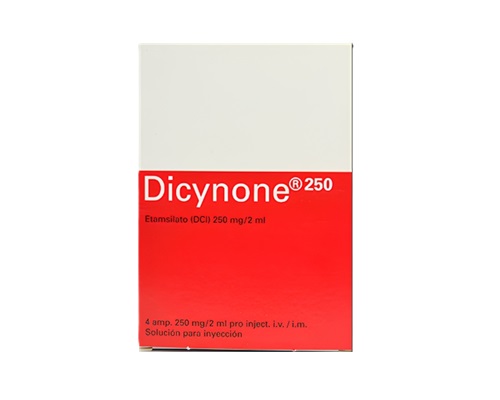Description
Trade name:
Dicynone
Compound:
Each tablet contains:
Etamsylate 500 mg
Auxiliary components:
Starch, microcrystalline cellulose, polyvinylpyrrolidone, stearic acid, sodium dihydrogen citrate, sodium sulfate anhydrous.
Properties:
A hemostatic agent, also has an angioprotective and proaggregant effect. Stimulates the formation of platelets and their release from the bone marrow. The hemostatic effect, due to the activation of thromboplastin formation at the site of damage to small vessels and a decrease in the formation of prostacyclin PgI2 in the vascular endothelium, promotes increased adhesion and aggregation of platelets, which ultimately leads to stopping or reducing bleeding. Increases the rate of primary thrombus formation and enhances its retraction, has virtually no effect on fibrinogen concentration and prothrombin time.
Indications:
– Prevention and control of hemorrhages in superficial and internal capillaries of various etiologies, especially if the bleeding is caused by damage to the endothelium;
– Prevention and treatment of bleeding during and after surgeries in otolaryngology, gynecology, obstetrics, urology, dentistry, ophthalmology and plastic surgery;
-Prevention and treatment of capillary bleeding of various etiologies and localizations;
– Hematuria, metrorrhagia, primary hypermenorrhea, hypermenorrhea in women with intrauterine contraceptive devices, nosebleeds, bleeding gums.
Method of administration and dosage:
It is used internally. The tablets are taken during or after meals with a small amount of water. Before surgery, take 1 tablet (500 mg) 1 hour before surgery. After surgery, take 1 tablet (500 mg) every 4-6 hours until the risk of bleeding disappears. For menorrhagia, take 1 tablet 3 times a day (1500 mg) for 10 days, starting from the 5th day from the expected onset of menstruation until the 5th day of the next menstrual cycle. The daily dose for children is half the adult dose.
Contraindications:
Hypersensitivity to etamzilat or any other component of the drug, acute porphyria, thrombosis, thromboembolism, increased blood clotting. Hemoblastosis (lymphatic and myeloid leukemia, osteosarcoma) in children.
Precautions:
Use with caution in patients with a history of thrombosis or thromboembolism. The drug is ineffective with a reduced platelet count. In case of hemorrhagic complications associated with an overdose of anticoagulants, it is recommended to use specific antidotes. Other causes of bleeding should be excluded before starting treatment.
Side effects:
– From the nervous system: headache, dizziness, hot flashes, paresthesia of the lower extremities.
– From the digestive system: nausea, vomiting, diarrhea, abdominal discomfort.
– From the immune system: hypersensitivity, allergic reactions, skin rash, urticaria, itching, a case of angioedema has been described.
– From the musculoskeletal system: arthralgia.
– From the circulatory and lymphatic system: agranulocytosis, neutropenia, thrombocytopenia.
– From the vascular system: thromboembolism.
Others: asthenia, fever, acute porphyria. All side effects are mild and transient. Children who used etamsylate to prevent bleeding in acute lymphatic and myeloid leukemia more often experienced severe leukopenia.
Storage method:
Store at temperatures not exceeding 30 degrees.





